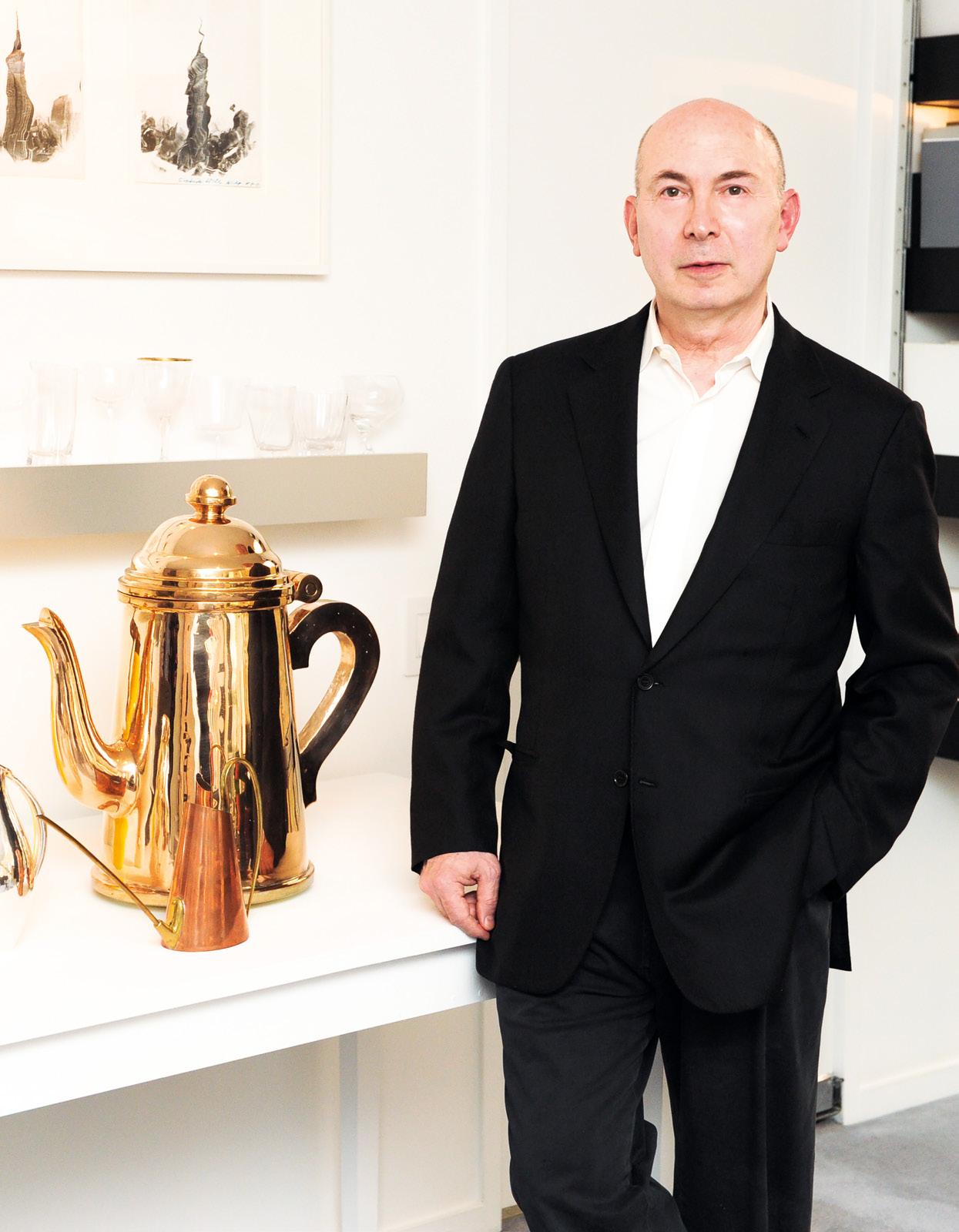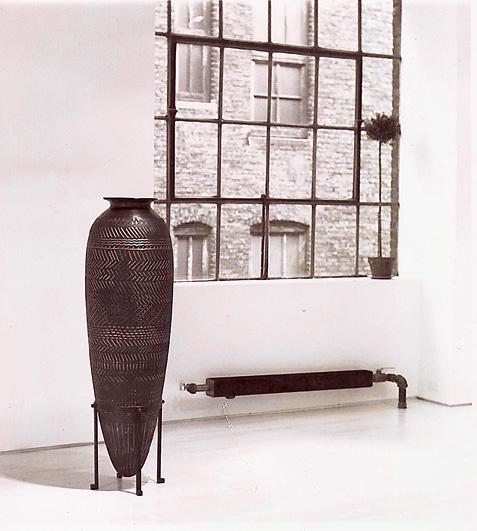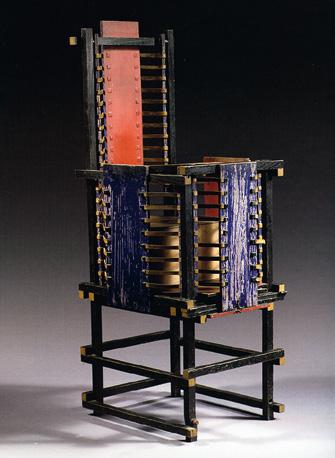4 minute read
OBSESSION IS A VIRTUE
Two legends of the design market tell Melissa Feldman how they began collecting, and where it has taken them since
“It turns out I love figurative things,” claims Murray Moss, when describing his first acquisition, a Royal Copenhagen porcelain statue of Leda and the Swan purchased from dealer Barry Friedman. “I’m pretty sure it was $324,” he says, adding, “I smoked an entire pack of cigarettes before I went inside to buy it.” Friedman concurs: “Moss was a very good client, would always buy something, and had good taste for someone so young.”
It’s worth noting that since that exchange over 50 years ago, both men have remained fixated on the quest, presentation, and sale of 20th- and 21st-century art, furniture, and design. Friedman opened several galleries showcasing his eclectic picks, highlighting multiple movements including Art Nouveau glass by Émile Gallé, Tiffany, and Loetz, as well as Art Deco and Art Nouveau furniture, photography, and Symbolist and Pre-Raphaelite painting. Moss landed a career in fashion with Ronaldus Shamask before honing his merchant skills with the launch of his eponymous store in SoHo in 1994. Moss insists, “I think that collecting is obsessing. That’s its main characteristic and virtue.”
Other finds scooped up from Friedman include a rare bear vase by Charles Catteau from the Belgian manufacturer Boch Frères Keramis. In 1976, Moss was hired by Macklowe Gallery, run by husband-and-wife dealers Barbara and Lloyd. There he got a crash course in antiques while purchasing pieces with provenance for more than his weekly wage, including an Armand-Albert Rateau Deco table designed for fashion designer Jeanne Lanvin. “I would say to Barbara Macklowe, ‘Can you get this for me?’ And she would say yes and I would own a Rateau table.” Moss also laments a Jean Dunand vase he purchased from dealer Martin Cohen for $10,000, which sold years later for a whopping $225,000 that became the down payment on his retail store.

Murray Moss in New York City, 2014.
Photo: Billy Farrell/BFA.com © BFA 2020
TAKE THE RIDE. LET THE OBJECTS TOTALLY POSSESS YOU
While Moss the shop was conceived as a retail destination, it also functioned as a de facto museum, design lab, and hub. Stocked with the most exquisite yet outré objects – from porcelain figurines manufactured by Nymphenburg, to Tord Boontje’s 2002 Blossom crystal chandelier for Swarovski – international curators, critics, dealers, and makers stopped by when traveling to New York. After Moss and his longtime life and business partner Franklin Getchell closed the boutique in 2012, they launched Moss Bureau; a design consultancy that they’ve since relocated into a Colonial Revival home in Connecticut. The pair now advises museums on how to build retail businesses, including product direction and store design.

This vase by Deco master Jean Dunand played a key role in Moss’s retail career.
Courtesy: Murray Moss
Looking back on his retail days, Moss, now 71, says: “I understood I was on a conveyor belt, which is why I called the store Moss. Once you call it ‘20th-century design’, you can’t ever sell anything else. To be on brand, it simply needed to be in my head. Barry [Friedman] was very much like that. I took courage from him.”
I’VE ALWAYS BEEN A COLLECTOR

“I’ve always been a collector,” says Friedman, whose passion was sparked by a purchase he made in 1966 – a vase by Loetz, a Bohemian glass manufacturer from Austria that flourished in the early 1900s. That exchange revealed the thrill of buying and selling, and the young accumulator was hooked. “I usually collected first, then studied it. Collecting gives you knowledge. I seldom took things on consignment,” Friedman adds.

Gerrit Thomas Rietveld, Red, blue, and yellow Schelling high chair, 1918, executed in the early 1920s
The Loetz transaction inspired Friedman to continue with his new obsession by renting a booth at a New York antiques center on the Upper East Side. In 1970, he was prompted, along with two partners, to open Primavera Gallery on Madison Avenue, specializing in Art Deco furniture, jewelry, and decorative arts. Several iterations followed, including Barry Friedman Ltd, which opened in 1975, staged in his apartment-cum-showroom and installed with stunning, soon-to-be-discovered treasures. An early adopter, Friedman helped establish a market for iconic 20th-century designers such as Émile-Jacques Ruhlmann, Wiener Werkstätte disciple Josef Hoffmann, and architect Jean Prouvé, to name a few.

Joris Laarman, Bone armchair, cast marble resin, 2008.
In the mid-1980s, Friedman partnered with photo dealer Edwynn Houk to exhibit vintage images by Man Ray and László Moholy-Nagy mixed with more avant-garde photography by Sally Mann. Since 2007, Friedman’s oeuvre has expanded with Friedman Benda Gallery, which he operates with Marc Benda and where he’s embraced more future-forward works by London-based designer Ron Arad and Dutch artist Joris Laarman. “I am still collecting after almost 60 years,” says Friedman, who in 2014 auctioned off 1,000 works from his vast collection, including art glass, photography, and 21st-century furniture. The 77-year-old has once again changed course, pivoting to antiquities from Southeast Asia, Cambodia, Tibet, Thailand, China, and Japan, between 1BC and 1AD.

Ron Arad, Solid rocker, stainless steel rods, 2010.
Moss maintains there’s something to be learned from all this trading. “Take the ride. Let the objects totally possess you. Because you should know, it will take you like a river to the next place. It’s not about the thing. It’s about, ‘Why are you so obsessed with a thing?’ Go for the high note. Then you can move on.”
Melissa Feldman is a writer and editor
Top Image: Marcel Breuer, wood-slat Lattenstuhl armchair, 1922–24

